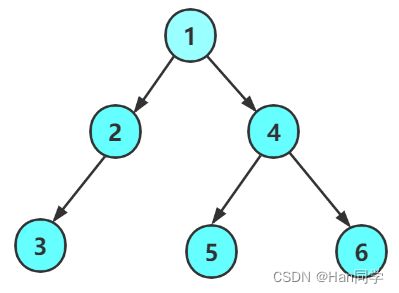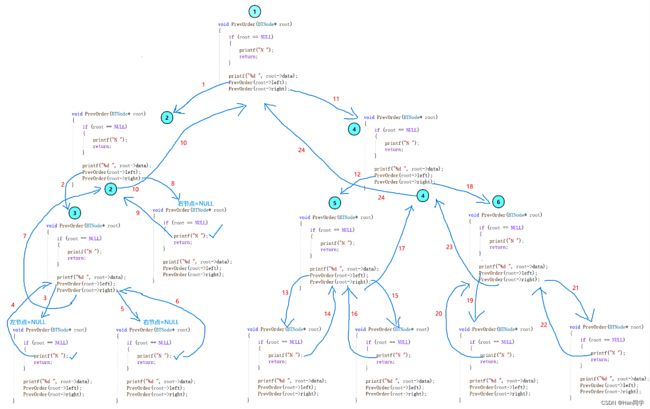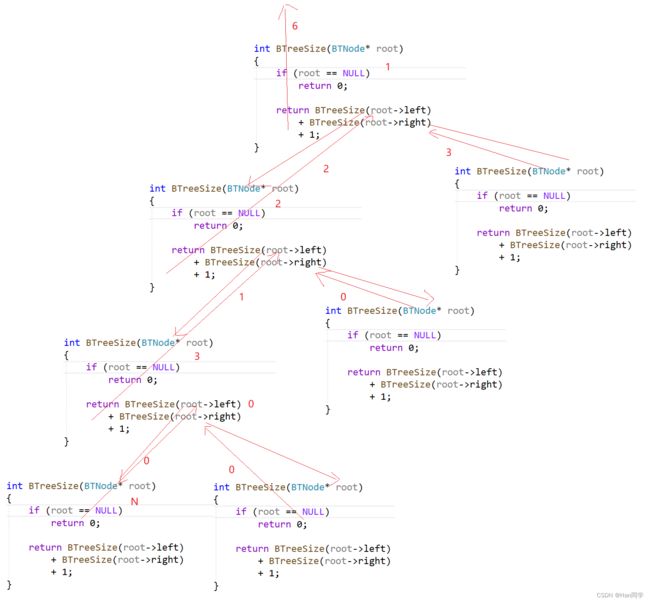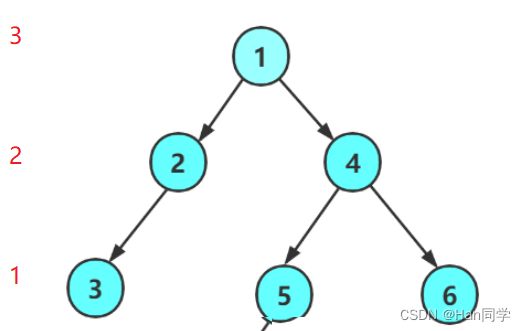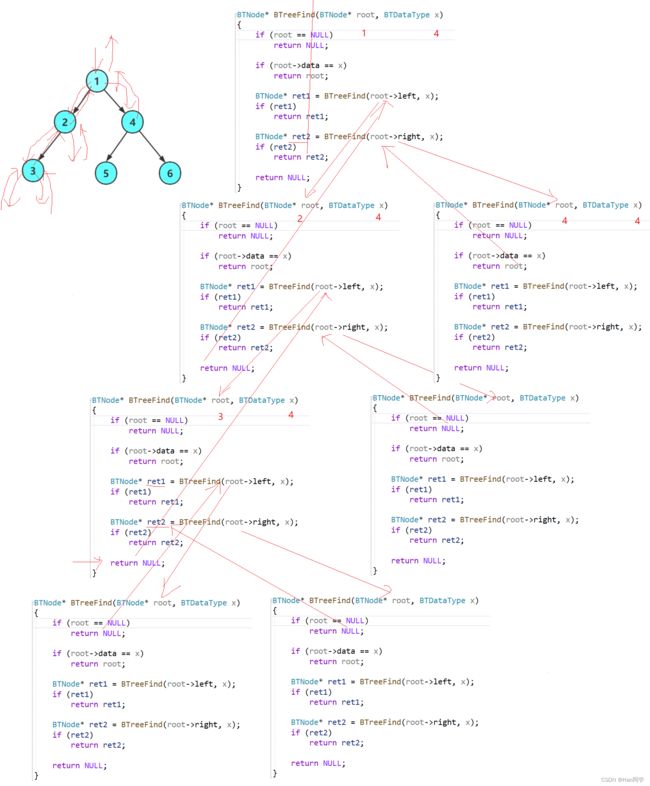数据结构与算法—“二叉树”的实现
目录
一、二叉树链式结构的实现
1、声明结构体
2、创建新节点
3、创建二叉树
二、二叉树的遍历
1、前序遍历讲解
2、节点个数
3、叶子节点个数
4、二叉树的高度
5、第k层节点个数
6、查找值为x的节点
完整版代码:
一、二叉树链式结构的实现
1、声明结构体
我们为二叉树的节点创建BTNode结构体,成员包含数据data、左节点和右节点的指针。
typedef int BTDataType;
typedef struct BinaryTreeNode
{
BTDataType data;
struct BinaryTreeNode* left;
struct BinaryTreeNode* right;
}BTNode;2、创建新节点
为新节点分配空间并初始化 。
BTNode* BuyNode(BTDataType x)
{
BTNode* node = (BTNode*)malloc(sizeof(BTNode));
if (node == NULL)
{
perror("malloc fail");
return NULL;
}
node->data = x;
node->left = NULL;
node->right = NULL;
return node;
}3、创建二叉树
我们创建七个节点,将它们连接起来,使其成为下图的形态:
BTNode* CreatBinaryTree()
{
BTNode* node1 = BuyNode(1);
BTNode* node2 = BuyNode(2);
BTNode* node3 = BuyNode(3);
BTNode* node4 = BuyNode(4);
BTNode* node5 = BuyNode(5);
BTNode* node6 = BuyNode(6);
BTNode* node7 = BuyNode(7);
node1->left = node2;
node1->right = node4;
node2->left = node3;
node4->left = node5;
node4->right = node6;
node5->left = node7;
return node1;
}二、二叉树的遍历
二叉树的遍历是一种系统地访问其所有节点的方法,这对于深入理解树的结构和特性至关重要。
遍历,本质上,是按照某一确定的次序,逐一访问二叉树中的每个节点,确保每个节点都被访问一次,并且只被访问一次。这种访问操作可以是任何针对节点的处理,具体取决于应用场景。
基于节点访问的先后次序,二叉树的遍历可以分为前序、中序和后序三种主要类型:
- 前序遍历(亦称为先序遍历):首先访问根节点,然后遍历左子树,最后遍历右子树。
- 中序遍历:首先遍历左子树,然后访问根节点,最后遍历右子树。
- 后序遍历:首先遍历左子树,然后遍历右子树,最后访问根节点。
这三种遍历方法都采用递归的方式来访问节点,为我们提供了一个明确且系统的方式来处理和理解二叉树。
我们用刚刚创建的二叉树来写出前、中、后序:
接下来,我们用代码实现遍历 ,验证咱们书写的前、中、后序是否正确:
1、前序遍历讲解
我们以前序遍历的方法为例进行讲解,中序和后序的遍历方法与其大同小异。
void PrevOrder(BTNode* root)
{
if (root == NULL)
{
printf("N ");
return;
}
printf("%d ", root->data);
PrevOrder(root->left);
PrevOrder(root->right);
}- 接收参数为根节点。
- 如果当前节点为空则输出打印N(表示NULL),不为空则输出当前节点的值。
- 递归调用PrevOrder函数遍历当前节点的左子树。
- 递归调用PrevOrder函数遍历当前节点的右子树。
函数会将当前节点的左子节点和右子节点作为参数传递给自身。这样,PrevOrder函数就可以在遍历完当前节点后,继续遍历左右子树。当遍历到叶子节点时,PrevOrder函数会直接返回,结束递归调用。
递归全过程如下图:(红色数字表示递归顺序)
前、中、后序遍历完整代码:
void PrevOrder(BTNode* root)
{
if (root == NULL)
{
printf("N ");
return;
}
printf("%d ", root->data);
PrevOrder(root->left);
PrevOrder(root->right);
}
void InOrder(BTNode* root)
{
if (root == NULL) {
printf("N ");
return;
}
InOrder(root->left);
printf("%d ", root->data);
InOrder(root->right);
}
void PostOrder(BTNode* root)
{
if (root == NULL) {
printf("N ");
return;
}
PostOrder(root->left);
PostOrder(root->right);
printf("%d ", root->data);
}
int main()
{
BTNode* root = CreatBinaryTree();
PrevOrder(root);
printf("\n");
InOrder(root);
printf("\n");
PostOrder(root);
printf("\n");
return 0;
}根据输出结果可知我们之前的计算结果正确!!!
2、节点个数
以下两种方式都可以,第二种比较简洁,二者效果相同。
int BTreeSize(BTNode* root)
{
if (root == NULL)
return 0;
return BTreeSize(root->left)
+ BTreeSize(root->right)+ 1;
}int BTreeSize(BTNode* root)
{
return root == NULL ? 0 : BTreeSize(root->left)
+ BTreeSize(root->right) + 1;
}
- 在函数内部,首先判断当前节点是否为空,
- 如果为空则返回0。
- 如果当前节点不为空,则递归调用BTreeSize函数计算当前节点的左子树和右子树中节点的个数,然后将它们相加,并加上当前节点本身,即可得到整个二叉树中节点的个数。
3、叶子节点个数
int BTreeLeafSize(BTNode* root)
{
if (root == NULL)
return 0;
if (root->left == NULL && root->right == NULL)
return 1;
return BTreeLeafSize(root->left)
+ BTreeLeafSize(root->right);
}
- 在函数内部,首先判断当前节点是否为空,如果为空则返回0。如果当前节点不为空,则判断当前节点是否为叶子节点。
- 如果当前节点是叶子节点,则返回1。
- 如果当前节点不是叶子节点,则递归调用BTreeLeafSize函数计算当前节点的左子树和右子树中叶子节点的个数,然后将它们相加,即可得到整个二叉树中叶子节点的个数。
4、二叉树的高度
int BTreeHeight(BTNode* root)
{
if (root == NULL)
return 0;
int leftHeight = BTreeHeight(root->left);
int rightHeight = BTreeHeight(root->right);
return leftHeight > rightHeight ? leftHeight + 1 : rightHeight + 1;
}
在函数中,首先判断当前节点是否为空。
如果当前节点为空,返回0。
如果当前节点不为空,则递归计算其左右子树的高度,分别保存在leftHeight和rightHeight变量中。
- 最后,通过比较左右子树的高度,得到较大值并加1,即为整个二叉树的高度。
- 这里使用了三目运算符,如果leftHeight大于rightHeight,则返回leftHeight+1,否则返回rightHeight+1。
5、第k层节点个数
int BTreeLevelKSize(BTNode* root, int k)
{
assert(k > 0);
if (root == NULL)
return 0;
if (k == 1)
return 1;
return BTreeLevelKSize(root->left, k - 1)
+ BTreeLevelKSize(root->right, k - 1);
}6、查找值为x的节点
BTNode* BTreeFind(BTNode* root, BTDataType x)
{
if (root == NULL)
return NULL;
if (root->data == x)
return root;
BTNode* ret1 = BTreeFind(root->left, x);
if (ret1)
return ret1;
BTNode* ret2 = BTreeFind(root->right, x);
if (ret2)
return ret2;
return NULL;
}
在函数中,首先判断当前节点是否为空。
如果当前节点为空,说明已经遍历到叶子节点仍未找到目标值,返回NULL。
如果当前节点的值等于目标值x,说明已经找到了目标节点,返回该节点指针。
如果当前节点不是目标节点,则递归查找其左右子树。
首先在左子树中查找目标值,如果找到则返回该节点指针;
如果在左子树中未找到,则在右子树中查找目标值,如果找到则返回该节点指针。
如果左右子树中都未找到目标值,则返回NULL。
查找值为 4 的节点过程如下:
完整版代码:
#include
#include
#include
typedef int BTDataType;
typedef struct BinaryTreeNode
{
BTDataType data;
struct BinaryTreeNode* left;
struct BinaryTreeNode* right;
}BTNode;
BTNode* BuyNode(BTDataType x)
{
BTNode* node = (BTNode*)malloc(sizeof(BTNode));
if (node == NULL) {
perror("malloc fail");
return;
}
node->data = x;
node->left = node->right = NULL;
return node;
}
BTNode* CreatBinaryTree()
{
BTNode* node1 = BuyNode(1);
BTNode* node2 = BuyNode(2);
BTNode* node3 = BuyNode(3);
BTNode* node4 = BuyNode(4);
BTNode* node5 = BuyNode(5);
BTNode* node6 = BuyNode(6);
//BTNode* node7 = BuyNode(7);
node1->left = node2;
node1->right = node4;
node2->left = node3;
node4->left = node5;
node4->right = node6;
//node5->left = node7;
return node1;
}
void PrevOrder(BTNode* root)
{
if (root == NULL)
{
printf("N ");
return;
}
printf("%d ", root->data);
PrevOrder(root->left);
PrevOrder(root->right);
}
void InOrder(BTNode* root)
{
if (root == NULL) {
printf("N ");
return;
}
InOrder(root->left);
printf("%d ", root->data);
InOrder(root->right);
}
void PostOrder(BTNode* root)
{
if (root == NULL) {
printf("N ");
return;
}
PostOrder(root->left);
PostOrder(root->right);
printf("%d ", root->data);
}
int BTreeSize(BTNode* root)
{
//两种都可以
/*if (root == NULL)
return 0;
return BTreeSize(root->left)
+ BTreeSize(root->right)
+ 1;*/
return root == NULL ? 0 : BTreeSize(root->left)
+ BTreeSize(root->right) + 1;
}
int BTreeLeafSize(BTNode* root)
{
if (root == NULL)
{
return 0;
}
if (root->left == NULL
&& root->right == NULL)
{
return 1;
}
return BTreeLeafSize(root->left)
+ BTreeLeafSize(root->right);
}
int BTreeHeight(BTNode* root)
{
if (root == NULL)
return 0;
int leftHeight = BTreeHeight(root->left);
int rightHeight = BTreeHeight(root->right);
return leftHeight > rightHeight ? leftHeight + 1 : rightHeight + 1;
}
int BTreeLevelKSize(BTNode* root, int k)
{
assert(k > 0);
if (root == NULL)
return 0;
if (k == 1)
return 1;
return BTreeLevelKSize(root->left, k - 1)
+ BTreeLevelKSize(root->right, k - 1);
}
BTNode* BTreeFind(BTNode* root, BTDataType x)
{
if (root == NULL)
return NULL;
if (root->data == x)
return root;
BTNode* ret1 = BTreeFind(root->left, x);
if (ret1)
return ret1;
BTNode* ret2 = BTreeFind(root->right, x);
if (ret2)
return ret2;
return NULL;
}
int main()
{
BTNode* root = CreatBinaryTree();
PrevOrder(root);
printf("\n");
InOrder(root);
printf("\n");
PostOrder(root);
printf("\n");
//printf("BTreeSize:%d\n", BTreeSize(root));
//printf("BTreeLeafSize:%d\n", BTreeLeafSize(root));
//printf("BTreeLeafSize:%d\n", BTreeLeafSize(root));
//printf("BTreeLevelKSize:%d\n", BTreeLevelKSize(root, 3));
//printf("BTreeLevelKSize:%d\n", BTreeLevelKSize(root, 4));
return 0;
} 